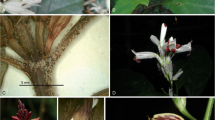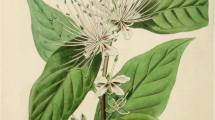Summary
Anthurium harleyi T.A.Pontes & Mayo, a new rupicolous species of Anthurium sect. Urospadix, is described from the rupestrian grassland (campo rupestre) vegetation of the northern region of the Chapada Diamantina, in central Bahia state, Brazil. The new species is endemic to this region, but closely related to A. erskinei Mayo from the central and southern regions of the same highland. A multivariate morphometric analysis of twelve quantitative morphological variables is presented which shows the two species to be distinct. A taxonomic description, line drawings, photographs, distribution map and conservation status based on a spatial analysis are provided.







Similar content being viewed by others
References
Andrade, I. M. & Mayo, S. J. (2010). Molecular and morphometric patterns in Araceae from fragmented Northeast Brazilian forests. In: O. Seberg, G. Petersen, A. S. Barfod & J. R. Davis (eds), Diversity, phylogeny and evolution in the Monocotyledons, pp. 115 – 128. Aarhus University Press, Aarhus.
Andrade, I. M. & Mayo, S. J. (2013). Araceae. In: F. França, E. Melo, I. Souza & L. Pugliesi (eds), Flora do Morro do Chapéu, Vol. 1: 130 – 134. Universidade Estadual de Feira de Santana, Feira de Santana.
Andrade, I. M., Mayo, S. J., van den Berg, C., Fay, M., Chester, M., Lexer, C. & Kirkup, D. (2007). Genetic variation in populations of Monstera adansonii Schott (Araceae) from natural forest fragments in Northeast Brazil estimated with AFLP molecular markers. Ann. Bot. 100: 1143 – 1154.
Bachman, S., Moat, J., Hill, A. W., de la Torre, J. & Scott, B. (2011). Supporting Red List threat assessments with GeoCAT: geospatial conservation assessment tool. In: V. Smith & L. Penev (eds), e-Infrastructures for data publishing in biodiversity science. ZooKeys 150: 117 – 126. (Version BETA).
Coelho, M. A. N. (2004). Taxonomia das espécies de Anthurium (Araceae) seção Urospadix subseção Flavescentiviridia. Ph.D. thesis, Universidade Federal do Rio Grande do Sul, Porto Alegre, Rio Grande do Sul.
Coelho, M. A. N., Waechter, J. L. & Mayo, S. J. (2009). Revisão taxonômica das espécies de Anthurium (Araceae) Seção Urospadix Subseção Flavescentiviridia. Rodriguésia 60: 799 – 864.
Fernandes, G. W. (2016). Ecology and Conservation of Mountaintop grasslands in Brazil. Springer International Publishing, Cham.
Giulietti, A. M., Pirani, J. R. & Harley, R. M. (1997). Espinhaço Range, eastern Brazil. In: S. D. Davis, V. H. Heywood, O. Herrera-Macbryde, J. Villa-Lobos & A. C. Hamilton (eds), Centres of Plant Diversity: a guide and strategy for their conservation. Vol. 3, The Americas, pp. 397 – 404. IUCN Publication Unit, Cambridge.
Haigh, A., Mayo, S. J. & Coelho, M. A. N. (2011). Four new species of Anthurium (Araceae) from Bahia, Brazil. Kew Bull. 66: 123 – 132.
Hammer, Ø., Harper, D. A. T. & Ryan, P. D. (2001). PAST: Paleontological Statistics Software Package for Education and Data Analysis. Palaeontol. Electronica 4: 1 – 9.
Harley, R. M. (1988). Evolution and distribution of Eriope (Labiatae), and its relatives, in Brazil. In: P. E. Vanzolini & W. R. Heyer (eds), Proceedings of a Workshop on Neotropical Distribution Patterns, pp. 71 – 120. Academia Brasileira de Ciências, Rio de Janeiro.
Harley, R. M.(1995). Introduction. In: B. L. Stannard (ed), Flora of the Pico das Almas: Chapada Diamantina - Bahia, Brazil, pp. 1 – 78. Royal Botanic Gardens, Kew.
Harley, R. M. & Giulietti, A. M. (2004). Wild Flowers of the Chapada Diamantina. Rima, São Carlos.
Krause, K. (1932). Araceae novae austro-americanae. Notizbl. Bot. Gart. Berlin-Dahlem 11: 606 – 622.
Legendre, P. & Legendre, L. (2012). Numerical Ecology. Third English Edition. Elsevier, Amsterdam.
Mayo, S. J. (1978). A new species of Anthurium (Araceae) from Bahia, Brazil. Bradea 2: 281 – 286.
Mayo, S. J. (1984). Aspectos da Fitogeografia das Aráceas Bahianas. Anais do XXXIV Congresso Nacional de Botânica, Porto Alegre, Rio Grande do Sul, Brazil, Vol. 2: 215 – 227.
Mayo, S. J. (1990). Problems of speciation, biogeography and systematics in some Araceae of the Brazilian Atlantic Forest. In: S. Watanabe (ed.), Anais do II Simpósio de Ecossistemas da Costa Sul e Sudeste Brasileira, São Paulo, Brazil, Vol. 1: 235 – 258. FAPESP, São Paulo.
Mayo, S. J. (1995). Araceae. In: B. L. Stannard (ed), Flora of the Pico das Almas, pp. 648 – 649. Royal Botanic Gardens, Kew.
Pontes, T. A. (2014). Estudo taxonômico das espécies de Anthurium Seção Urospadix (Araceae) endêmicas ao sertão central da Bahia, baseado em dados genéticos e morfométricos, e enfocando e-taxonomy. Ph.D. thesis, Universidade Estadual de Feira de Santana, Feira de Santana, Bahia.
Pontes, T. A., van den Berg, C., Andrade, I. M. & Mayo, S. J. (2014). Measuring relative flower size in Anthurium (Araceae) as a continuous quantitative character. Phytotaxa 178: 171 – 180.
Pontes, T. A., Andrade, I. M., Schultz, M. & Mayo, S. J. (2016). Ernst Ule's collecting localities in the Serra do Sincorá, Bahia, Brazil and the lectotypification of Anthurium petrophilum (Araceae). Phytotaxa 266: 80 − 90.
R Core Team (2017). R: A Language and Environment for Statistical Computing. R Foundation for Statistical Computing. Vienna, Austria. Available online at: https://www.R-project.org. Accessed 15 June 2017.
Rapini, A., Ribeiro, P. L., Lambert, S. & Pirani, J. R. (2008). A flora dos campos rupestres da Cadeia do Espinhaço. Megadiversidade 4: 16 – 24.
Rasband, W. S. (2017). ImageJ, U. S. National Institutes of Health, Bethesda. Available online at: https://imagej.nih.gov/ij/ [accessed 15 June 2017].
Richards, R. S. & Mayo, S. J. (2009). A morphometric analysis of two lithophytic species of Anthurium from Bahia, Brazil. Poster presented at X International Aroid Conference, Nancy Botanical Garden, 8 – 10 July 2009. Available online at: http://araceae.e-monocot.org/node/4013. Accessed 15 June 2017.
Rivers, M. C., Taylor, L., Brummitt, N. A., Meagher, T. R., Roberts, D. L. & Lughadha, E. N. (2011). How many herbarium specimens are needed to detect threatened species? Biol. Conservation 144: 2541 – 2547.
Sakuragui, C. M. & Mayo, S. J. (2003). Araceae. In: D. C. Zappi, E. Lucas, B. L. Stannard, E. N. Lughadha, J. R. Pirani, L. P. Queiroz, S. Atkins, D. J. N. Hind, A. M. Giulietti, R. M. Harley & A. M. Carvalho (eds), Lista das plantas vasculares de Catolés, Chapada Diamantina, Bahia, Brasil. Bol. Bot. Univ. São Paulo 21: 392.
Shorthouse, D. P. (2010). SimpleMappr, an online tool to produce publication-quality point maps. [Retrieved from http://www.simplemappr.net. Accessed 13 November 2017.
SpeciesLink (2017). O projeto speciesLink. Available online at: http://www.splink.org.br. Accessed 12 June 2017
Temponi, L. G. (2006). Sistemática de Anthurium sect. Urospadix (Araceae). Ph.D. thesis, Instituto de Biociências, Universidade de São Paulo, São Paulo.
Troll, W. (1959). Allgemeine Botanik: Ein Lehrbuch auf vergleichend-biologischer Grundlage. F. Enke, Stuttgart.
Acknowledgements
This work is part of the PhD thesis of the first author and was only possible due to financial support from the following partners: Conselho Nacional de Desenvolvimento Científico e Tecnológico–CNPQ, for the scholarship n° 147709/2010–5; Fundação de Amparo à Pesquisa do Estado da Bahia–FAPESB, T.O. PNX0014/2009, for financing field excursions; and the Universidade Estadual de Feira de Santana–UEFS, for logistic support. We are most grateful to Lucy Smith for her very fine illustration. SJM thanks the staff of the Herbarium André Maurício Vieira de Carvalho, Centro de Pesquisas do Cacau (CEPEC), Itabuna, Bahia, and Raymond Harley (K) for botanical support and encouragement over many years, and the Royal Botanic Gardens Kew for support via an Honorary Research Associateship.
Author information
Authors and Affiliations
Corresponding author
Additional information
Publisher’s Note
Springer Nature remains neutral with regard to jurisdictional claims in published maps and institutional affiliations.
Rights and permissions
About this article
Cite this article
Pontes, T.A., de Andrade, I.M., Richards, R.S. et al. Anthurium harleyi (Araceae) — a new rupicolous species of section Urospadix from the northern Chapada Diamantina, Bahia, Brazil. Kew Bull 74, 11 (2019). https://doi.org/10.1007/s12225-019-9796-3
Accepted:
Published:
DOI: https://doi.org/10.1007/s12225-019-9796-3




